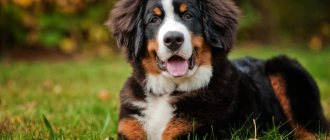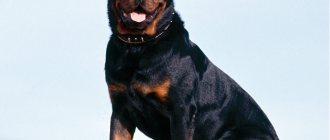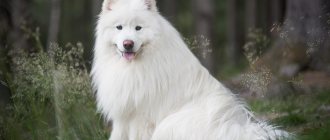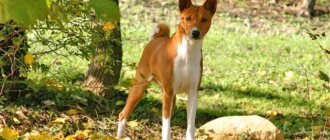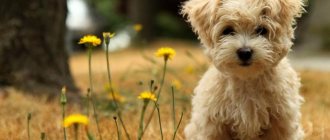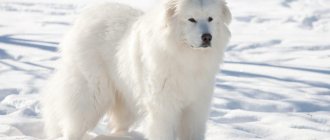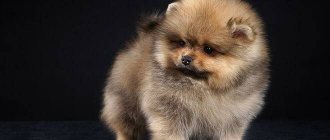- Dogs
The concept of guard dog breeds usually means four-legged service dogs that have innate skills or good results in training in the following “disciplines”: protective guard, sentry, escort, sentinel and sentry service. In the common understanding, guard dogs are bred to protect property, territory or a person (owner). Differences in the theory and understanding of the “majority” give rise to a lot of controversy. Let us immediately note that all service breeds are universal to one degree or another, and a good trainer will teach any dog how to guard. The question is whether the four-legged animal feels that guarding is his duty and calling or whether he “defends” the object because it is necessary. Below, we will look at the photos and names of breeds that are worth having for protection.
Ninth place – Moscow Watchdog
Despite the fact that this dog breed was developed relatively recently, it has already won the trust of many people. The main feature of Moscow guard dogs is their size - these dogs are huge and look intimidating. The Moscow Watchdog is not just an excellent guard, but also a devoted friend. There are never any problems with dogs of this breed.
Read more about the Moscow Watchdog breed
Miniature Schnauzer
Intelligence, attentiveness, ideal endurance - this is the psychological portrait of the smallest (only 4-8 kg) dog of a service breed called a miniature schnauzer. This is a fearless and vigilant guard, ready to defend the territory, home, and owner to the end.
A cheerful disposition and agility harmoniously complement a balanced character, which makes the miniature not only an ideal guard, but also a cheerful companion for active games.
Do you want a bigger dog? Read these articles:
Dogs for site protection: the best large and medium breeds
Dogs for land protection: the best giant breeds
Do you want a dog that will catch rats? See here:
Dogs that catch rats and mice no worse than cats (the most catching breeds)
Are you choosing a guard among the mongrel puppies? Here:
Outbred puppy: how to understand what size it will grow?
Future companion, guard or hunter? How to determine the character of a mongrel puppy
Helpful Tips:
A dog for guarding an area: what it should be, the difference between guard and security, the best breeds
The ability of dogs to guard depends primarily on pedigree and genetic factors. Therefore, when choosing a guard puppy, you need to ask how these qualities are developed in its parents.
But when raising a security guard, education and proper training play an important role. Such dogs should have minimal contact with strangers so that they listen only to their owner. She should not allow herself to be petted, and when she tries to do this, she usually moves her head away or shows her teeth.
How to choose the right security guard? What should you pay attention to? Is training skill important? Below is a brief overview and instructions for choosing the right breed.
The best guard dogs for a country house or apartment are those that are ready to start a fight with any number of rivals that threaten the owner. Sometimes this happens at the will of the owner, and sometimes the dog assesses the situation himself. Moreover, the size of the dog does not matter. The main deciding factor is the presence of muscle mass, body constitution, character and temperament.
The Staffordshire Terrier is smaller than the Retriever, but physically superior in all respects. It is also worth paying attention to the conditions of detention, because capricious dogs will be distracted from work in every possible way if they do not receive all the necessary conditions. Some breeds can only be trained to guard and serve if trained by a professional dog handler.
IMPORTANT! For any dog, the family is its own pack, and outside groups of dogs, and other dog groups are another pack. He perceives the owner as a leader and obeys him. Sometimes a dog may perceive the entire family as comrades, without a clear hierarchy.
It is very important that the dog distinguishes strangers from family friends or social service workers (postman, janitor, policeman) and does not attack them. Remember that if a dog is too friendly, it will obey everyone, and this cannot be allowed, because then its protective functions will be suppressed.
Bodyguard dog for humans
Any dog that has security and guard skills can become protection for a person. Moreover, even if these skills are weakly expressed and the pet is not a worker. Thanks to his boundless devotion and love, he is able to protect his master in any dangerous situation.
A stable nervous system and psyche of the pet is another important factor. For example, a dog that is afraid of everything will be able to bite an enemy, but only if it is he who is in danger. In turn, a large and kind dog will get involved in a squabble, defending its owner.
Thus, we can conclude that a properly raised animal with a balanced psyche can become an excellent bodyguard for a person.
The guard dog is entrusted with a special mission - protection, protection of the owner and his property. With the right approach, the dog will cope with this task perfectly. In fact, a representative of any breed is capable of becoming a guard, but for this each dog must be trained. It is important not to forget, whatever the character of a four-legged friend, a person takes full responsibility for his behavior and upbringing.
How to train a dog to guard children
When training a dog to protect its child, keep in mind that the desire to stand up for its owner can sometimes have negative consequences. Even a playful game of tag can be perceived as an attempt to attack a child. For example, if a child runs away from a friend on the street. But if you still want to find a guardian for your child and family, choose easy-to-train breeds with a good disposition. You can teach him certain skills for protecting loved ones so that you can send your children for a walk with your pet without fear. For example, when trying to pull a bag or wallet out of your hands, the dog may begin to bark or attack.
You can be assisted in your training by a trainer who, together with you and your child, will learn all the necessary commands. Such a person will give you recommendations and tell you about the individual characteristics of your dog.
When training a dog yourself, you need to understand the purpose of each command and its necessity. There are more than a dozen types of different tricks, as many skills and even more methods of raising pets.
Eighth place – Alabai
This breed of dog is a good guard, but a difficult learner. Alabai is difficult to train and rarely listens to its owner. To ensure that problems never arise with a dog of this breed, it should only be owned by a person who can easily find a common language with every dog.
Read more about the Alabai breed
Friend to family
Among the many different breeds of dogs, there are some that get along well with the family. When you have a child, it is very important to understand what issues may arise if you purchase a dog. Of course, these are additional costs for food, the need to allocate time for such necessary walks, training and raising the dog. In addition, it is worth considering that a child may have an allergic reaction to wool. But, compared to the troubles considered, the joy and positive emotions of children will be the best reward. Don't be afraid to give a gift to your son or daughter when getting a dog. In addition, there are breeds whose fur does not cause an allergic reaction.
For a dog to become a friend for a child, talk to him about how to communicate with an animal, what each family member will now have to do. Distribute responsibilities and get ready to meet a new friend, not just a pet.
Seventh place – Caucasian Shepherd
Caucasians are unpretentious, keeping a dog of this breed is very easy. The appearance of the Caucasian Shepherd is not just terrifying; at the sight of this dog, not a single thief will even try to break into the yard or apartment. However, despite their menacing appearance, Caucasians are very friendly and loyal to their owners. Naturally, like any dog, the Caucasian Shepherd needs to be trained and taught, otherwise problems may arise with it.
Read more about the Caucasian Shepherd breed
Large breeds for private sector protection
German Shepherd
If you need a dog to guard a house on the street, or an apartment, then a German Shepherd is the ideal choice. This breed is very trainable, remembers commands for a long time even after a long period of inactivity, is good with children and is an unsurpassed protector. The fury of a German Shepherd is enough for a gang of robbers, and the affection is enough for all family members.
When adopting a German Shepherd, remember that this breed is incredibly active and requires increased physical activity. Any owner who has adopted a dog for protection and security must take care of the physical development of the pet. By the way, Germans take third place in the list of the smartest dogs.
Giant Schnauzer
For him, guarding a private home is his favorite pastime. Unpretentious, loyal and incredibly brave, the Giant Schnauzer is a formidable guard who will not be afraid of the devil or God when it comes to protecting his owner. Rizens are easy to train, gentle towards children and affectionate towards their owners.
This breed is very active and will not miss the opportunity to frolic with its owner. Be sure to physically exhaust the dog so that all the dog’s energy is directed in a peaceful direction, and also contributes to the gain and maintenance of muscle mass. Perhaps the only drawback of the Giant Schnauzer may seem to be grooming.
Caucasian Shepherd Dog
The breed is one of the largest, so there is no need to say what will happen to those who decide to visit you with bad intentions. The strength of the Caucasian Shepherd Dog will be enough to defeat a pack of wolves in the face of ill-wishers, devotion - so as not to abandon the owner in difficult times, and kindness to steadfastly endure any childish pranks and rejoice at every step of the owner.
Being a very large breed, the Caucasian Shepherd does not require long walking. 1-1.5 hours of walking a day with the opportunity to frolic is enough to maintain the pet’s physical strength at a level.
Alabai or Asian Shepherd
In some ways, these dogs are similar to Caucasian Shepherds, they are also very ferocious and large dogs. True, they are not as shaggy as Caucasian Shepherds. Alabai are difficult to train, they can be stubborn and are happy to demonstrate this character trait to everyone. Therefore, we advise you not to get this dog if you do not have experience in training such animals. If you have no experience, but you have already got a dog, then we advise you to apply for training to special schools where experienced instructors work. The Asian Shepherd is a reliable protector of your family and home.
Giant guard dogs
Giant dogs are intended to be kept in private homes. They have innate guardian instincts. These are fearless fighters who can handle any other dog or person.
Anatolian karabash
Height – up to 80 cm, body weight – up to 65 kg. An ancient breed originally from Turkey. The dog has a large, powerful body, a large head with developed jaws and a characteristic scissor bite. The tail is straight, the ears are triangular and drooping. Color: plain, combined, tricolor.
The Anatolian Karabash has a stable psyche, he is devoted to his owners and gets along well with people. Excellent learner, remembers commands from an early age.
The Anatolian Karabash is an excellent property guard. He has a developed sense of ownership; he will not let anyone touch the owners’ things.
Advantages:
- good learning ability;
- equilibrium;
- Can live outside all year round.
Flaws:
- loud barking;
- tendency to allergic reactions.
Brazilian Fila
Height – up to 75 cm, minimum weight – up to 50 kg. The homeland of the huge dog is Brazil; the breed was first brought to Russia in 1992.
The Fila Brazilian impresses with its powerful body and folded skin. The coat is short and smooth, the color is uniform. According to breed standards, brindle and black colors are allowed.
The Brazilian Fila does not trust strangers. Only a confident, experienced owner can handle it; the dog will be devoted to him and his family members.
The breed requires socialization and training. Fil can be trained by a leader in whom the dog recognizes authority. This is an excellent family guard; he strives to protect everyone who lives in the same territory with him.
Advantages:
- impressive appearance;
- excellent security qualities;
- devotion to family.
Flaws:
- possible difficulties in training;
- aggression towards other people's animals and children.
Bullmastiff
Height – up to 69 cm, weight – up to 59 kg. The breed was developed in England in the 19th century.
The Bullmastiff has a wide chest and well-developed muscles. The color is red, fawn or brindle. Loyal to his owners, wary of strangers. The Bullmastiff is willful, but disciplined. The dog is hardy and easy to train.
The Bullmastiff protects the territory entrusted to it. Gets along well with other animals in the house.
Advantages:
- finds a common language with children;
- rarely barks;
- does not require high loads.
Flaws:
- excessive salivation;
- tendency to gastrointestinal diseases.
Dogue de Bordeaux
Height – up to 68 cm, weight – from 50 kg. The breed originated in France. The dog is very large, with a powerful body and head. Solid color in all shades of red.
Dogues de Bordeaux are balanced and sociable, loyal to their owner. They show aggression towards rivals – large dogs. Males are tougher than females.
The dog needs strict training from an early age. These are good guards for owners and guardians of their property.
Advantages:
- devotion;
- friendly attitude towards children;
- does not require long walking.
Flaws:
- tendency to obesity;
- requires patience in training.
Dogo Argentino
Height – up to 68 cm, weight – up to 45 kg. The breed was bred in Argentina.
The Dogo Argentino is proportional, it has a wide back and a powerful neck, and a deep chest. The coat is short and smooth.
The character is calm and friendly. It is trained and amenable to commands if it recognizes its owner as an absolute leader.
Used as a hunting and fighting dog. Dogo Argentinos are popular in various canine disciplines.
Advantages:
- strong immunity;
- fearlessness;
- high endurance.
Flaws:
- sensitivity to low temperatures;
- not suitable for living in an apartment;
- predisposition to allergies.
Black Russian Terrier
Height – up to 76 cm, weight – up to 60 kg. The breed was bred in the second half of the 20th century in the USSR.
A stretched dog with a large head. The coat is coarse and thick, with undercoat, and requires grooming.
The dog has a sense of self-esteem. The terrier is self-confident and hardy. Can easily become defensive towards strangers. He is well trained and amenable to commands.
The breed is used for protective guard duty. Able to detain and escort violators.
Advantages:
- good health;
- unpretentiousness in content;
- excellent performance.
Flaws:
- requires a lot of attention;
- Regular physical and mental exercise is required.
Giant Schnauzer
Height – up to 70 cm, weight – up to 47 kg. The breed was bred in Germany.
This is a square dog. The coat is hard, wiry, and dense. Two colors: black and salt and pepper.
The Giant Schnauzer is distinguished by its friendliness and fearlessness. Friendly to members of his family living in the same territory, wary of strangers.
The breed is used for personal protection and property protection.
It is easy to train and can only be 100% submissive to its owner. Needs intense exercise.
Advantages:
- high intelligence;
- excellent security and guard qualities;
- receptivity to learning.
Flaws:
- complex grooming;
- stubbornness;
- aggression towards strangers due to lack of education.
Moscow watchdog
Height – from 68 cm, weight – from 55 kg. The breed was bred in the mid-19th century. in Moscow.
A large breed with a massive head and well-developed muscles. The coat is long and dense, with a thick undercoat. According to breed standards, the presence of a red tint in color is mandatory.
This is a balanced, independent, sociable dog. Fearless, needs a lot of personal space. Not suitable for keeping in a small apartment.
The dog easily learns basic commands. Submits to all family members. The main task of the Moscow watchdog is to protect the owners and the territory allocated to it.
Advantages:
- good health;
- possibility of keeping in an enclosure;
- friendliness.
Flaws:
- tendency to obesity;
- The fur sheds a lot.
Caucasian Shepherd Dog
Height – from 68 cm, weight – from 50 kg. An ancient breed, its homeland is the Caucasus.
A massive dog with a large head, a voluminous chest, and straight paws. Colors allowed are fawn, brown, white, and motley. The coat is thick, long, fluffy, and has an undercoat.
The Caucasian Shepherd is brave and determined. Wary of strangers, capricious character.
Needs strict education and training. It is necessary to suppress any manifestation of aggression towards the owner.
Caucasians are used for protective guard duty. The instinct to protect their territory is very strong in them.
Advantages:
- fearlessness;
- unpretentiousness;
- ideal home guard.
Flaws:
- not suitable for living in an apartment;
- aggression towards strangers with poor training;
- does not tolerate heat well.
Central asian shepherd dog
Height – from 70 cm, weight – from 50 kg. This is an ancient breed native to Central Asia.
It is distinguished by a powerful body with a large head and short neck. The coat can be short or long. Color: black, white, fawn, red.
The Shepherd is friendly to its family members. Ready to attack a stranger if he poses a threat. Restrained towards friendly strangers.
Strict training is necessary, it is important to achieve absolute obedience, otherwise the dog will not be able to be controlled. An experienced dog breeder can make him follow commands.
The breed is used for protection and guard duty.
Advantages:
- high intelligence;
- endurance;
- fearlessness.
Flaws:
- high level of aggression towards other animals;
- difficulties in training.
Tibetan mastiff
Height – from 66 cm, weight – up to 80 kg. The oldest breed comes from Central Asia.
A powerful dog with a wide body, large head and well-developed muscles. The coat is coarse, thick, straight, with a thick fluffy undercoat. Color black, blue, sable.
Mastiffs are calm and reserved, tolerant of children. These dogs are very smart.
Socialization and training are vital for mastiffs. Beginner dog breeders will not be able to cope with this. If you don't give your mastiff a lot of time, he will become withdrawn and uncontrollable.
These are excellent guards of the territory; at night they are more active than during the day.
Advantages:
- excellent security qualities;
- unpretentiousness in nutrition;
- independence.
Flaws:
- danger to strangers with poor education;
- heavy shedding;
- should not be kept in apartments.
Leonberger
Height – up to 80 cm, weight – up to 65 kg. The breed was bred in Germany.
A harmonious dog with a muscular build. The coat is soft, long, lying close to the body. Color – all shades of red.
Leonberger is sociable, obedient, and excellent with children. Not aggressive, friendly companion. Amenable to training when practiced from an early age.
The breed is focused on protecting the territory of its family. This is a wonderful family dog.
Advantages:
- equilibrium;
- obedience;
- can be used as a guide.
Flaws:
- a long walk is required;
- difficult grooming.
Sixth place – Doberman
The Doberman is an excellent home guard dog. This breed is a service breed, so these pets are very smart and quick-witted. The house is under the supervision of a Doberman and never receives unwanted guests. Having such a dog, you don’t have to worry about the safety of your money and other valuables. In addition to its security abilities, the Doberman is an excellent companion and loyal friend.
Read more about the Doberman breed
What to consider when raising a puppy
- It is necessary to completely or at least partially limit the animal’s communication with strangers. In such conditions, the pet will treat every stranger with distrust and suspicion: without this feeling, full-fledged protection of the territory is impossible.
- Don't forget to take your dog for walks and introduce him to new places. She must behave calmly and confidently in different situations.
- A protective dog cannot help but be a leader. Allow the puppy to win games, but only until a certain age (6-7 months), otherwise the desire to overcome the owner may develop into aggression.
This is interesting! A good option for those who want to achieve ideal training are special courses in which the animal is taught obedience and following various commands.
Video
Fifth place – Cane Corso
The Cane Corso is a very expensive and rare breed of dog. Animals of this breed are very kind, well-mannered and patient. But when it comes to the life and health of the owner, Cane Corsos turn into a ferocious beast that is capable of tearing anyone apart. That is why this breed of dog is suitable for guarding apartments and private houses.
Read more about the Cane Corso breed
Apartment security guard
A more stringent selection is required here, because the pet will live side by side with a person. Sometimes the main criterion is the size of the animal, especially if we are talking about modest areas. But for fans of large and giant breeds, this factor is not decisive, and they get a mastiff or Great Dane while living in a small apartment.
If we talk about average indicators, most future owners pay attention to the following:
- the dog must be medium or small in size;
- it is desirable that the animal sheds little or does not have this tendency at all and does not have the characteristic smell of a dog;
- short coat;
- the pet should not have excessive salivation;
- the dog must be clean;
- the animal should not be hyperactive and require a lot of space.
Of course, the owner himself determines what is important to him and what he can “turn a blind eye to.”
What are the benefits of a dog for a child?
Psychologists say that if your daughter or son comes up with the idea of getting a dog, this indicates that subconsciously he or she is ready for responsibility . But before buying, it’s better to take them on an excursion to those who have a pet, so that they can see what troubles await them.
Four-legged animals help a person fight insecurities and complexes, and improve the baby’s health. He will also become more responsible, more open in the company of his peers, and get accustomed to the regime.
Fourth place – Boxer
The Boxer is a very strong and strong dog. He quickly remembers all commands and always obeys his owner. This dog breed is popular all over the world, and very often, these dogs are bred as guards.
The Boxer gets along well with children and other pets, he will always be a loyal friend and an excellent bodyguard.
Read more about the Boxer breed
Schipperke
Owners often call Schipperkes little devils. The weight of an adult Schipperke is about 7 kg, but do not underestimate its watchdog qualities!
Schipperke is an exceptionally sensitive, vigilant guard, very energetic and capable of biting a thief who has entered the area without hesitation. He is suspicious of all strangers, and bribing him with food will not work. Before an attack, he always barks, which allows a prudent stranger to quickly leave the area.
Schipperke works no worse than an alarm system and is very convenient for keeping in the area near the house in which the owners live permanently. This little guard does not take up much space, is friendly to the whole family, and affectionate with children. In addition, like a cat, it destroys all rats, moles and other rodents on the site.
And 2 more breeds were added to this list on the advice of readers:
Swiss Mountain Dog
| Origin: | Switzerland |
| Dimensions: | Height of males is 65–72 cm, weight 50–64 kg. Bitches height 60–69 cm, weight 48–54 kg |
| Character: | Calm, balanced, active, sociable |
| Where used: | Sennenhund is an excellent watchman, guard, companion |
| Lives: | 10–11 years |
| Color: | Black with white and red tan |
The Greater Swiss Mountain Dog was bred in the Swiss Alps. Uncontrolled selection of native species with the mastiff imported from Italy is likely. A versatile dog, it is ideal for keeping on a farm. The Swiss Mountain Dog is a watchman and guardian of the territory, livestock and owners. Carries luggage and gives rides to her adored children.
Active, in motion, yet calm, balanced and friendly. The Swiss Mountain Dog is good as a family dog and companion, but prefers a yard and spacious premises. The dog is large and strong, with heavy bones and developed muscles. The breed standard calls for a three-color coat: black with a white chest, white and tan muzzle and red tan marks.
By the end of the 19th century, the Swiss Mountain Dog breed was almost lost. Cynologist enthusiasts restored her. One legend claims that the Mountain Dog descended from large mastiffs that accompanied Roman legionnaires in the Alps. Another one tells the story of the Phoenicians and Spanish dogs who gave rise to the Mountain Dog breed a millennium BC.
Medium guard dogs
Ideally sized dogs are energetic and friendly. They are sociable and can be used as companions. Such dogs are always ready to protect their owner from aggression. Their security qualities are excellent, as evidenced by their alertness, good hearing and instinct.
American Pit Bull Terrier
Height – up to 60 cm, weight – up to 45 kg. The breed comes from America. The back is short, the chest is deep, the head is square in shape with powerful jaws. The muscles are well developed.
The character is combative, with an increased level of aggression. Requires early training. The dog is first socialized and then taught commands. American Bull Terriers are excellent watchdogs and guards. Russian and foreign police use them to search for explosives and drugs.
Advantages:
- developed sense of smell;
- fearlessness;
- pronounced protective qualities.
Flaws:
- aggression towards strangers;
- requires long active walks;
- not suitable for yard keeping
Airedale
Height – up to 61 cm, weight – up to 29 kg. The breed originated from England. A square dog with a long neck. The tail is set high. The coat is hard, dense, dense with a short soft undercoat.
Airedale Terriers are good companions. They are smart and lend themselves well to applied types of training.
This breed has a low level of aggression; they are not adapted to defending territory, but do a good job of protecting their owner.
Advantages:
- flexible character;
- sociability;
- good learning ability.
Flaws:
- difficult grooming.
Miniature Schnauzer
Height – up to 50 cm, weight – up to 20 kg. The breed originated in Germany. This is a muscular dog with an elongated head. Ears are semi-erect or cropped. The coat is long, hard and dense. Color black or pepper and salt.
Miniature Schnauzers are active, unfriendly to children, and aggressive towards strangers. They need a lot of attention and constant socialization. When training, it is necessary to suppress excessive aggression from a very early age.
Miniature Schnauzers are used for territory guarding and for personal protection. They are good companions for their owners.
Advantages:
- unusual exterior;
- fearlessness;
- can be kept in an apartment.
Flaws:
- complex grooming;
- aggression towards strangers;
- desire for dominance.
Boxer
Height – up to 63 cm, weight – up to 30 kg. The breed was bred in Germany. The dog is square in size, strong and compact. The muzzle is wide, the hair is short, hard, smooth.
Boxers are distinguished by their loyalty and balance. They are attached to their owners and love children. Fearless, suspicious of strangers.
The dog is easy to train, you can start training from an early age. Boxers are excellent personal guards and house watchmen.
Advantages:
- playful nature;
- intelligence;
- learning ability
Flaws:
- tendency to catch colds;
- aggression towards strangers.
Korean Jindo
Height – up to 55 cm, weight – up to 23 kg. The breed comes from South Korea. The dog is square in size, with a deep chest and straight, long limbs. The tail is curved in the shape of a half ring and touches the back. The coat is thick, with a dense undercoat.
The Chindo is a very energetic breed. It is better to walk them alone; aggression towards other people's animals is possible. At the same time, the breed is excellent at training and easily makes contact with humans. Chindos have well-defined watchdog qualities; they are reliable guards of the territory.
Advantages:
- loyalty;
- activity;
- Possibility of use as a game hunter.
Flaws:
- negative attitude towards water procedures;
- can spoil things out of boredom.
Third place – Rottweiler
Dogs of this breed are very kind and attentive to children and other household members. Rottweilers are easy to train and quickly remember new information. Due to its calm nature, the Rottweiler can be kept both in an apartment and in a house. Dogs of this breed are very easy to care for.
Read more about the Rottweiler breed
Small guard dogs
Small guard dogs are the result of the work of breeders. They will not be able to detain the criminal, but they will warn the owner of the danger. They can be kept in an apartment quite easily.
Miniature Schnauzer
Height – up to 35 cm, weight – up to 8 kg. The breed appeared at the end of the 19th century. in Germany. A square-shaped dog with very thick and coarse hair. Color – black, pepper and salt, black and silver, white, chocolate.
The Miniature Schnauzer is active, quick-witted, distrustful of strangers, and does not like loneliness. Understands commands, but is in no hurry to carry them out. Training requires persistence.
Miniature Schnauzers are used as guards of the territory entrusted to them, rodent hunters.
Advantages:
- unusual appearance;
- good guard and security qualities;
- child friendly.
Flaws:
- loud barking;
- complex grooming;
- stubbornness.
Boston Terrier
Height – up to 38 cm, weight – up to 11 kg. The breed was developed in the 19th century. in USA. Boston Terriers have a wide back and a voluminous chest, and a square muzzle. The coat is short and thin. The tail is set low.
The dog is friendly and inquisitive, not prone to aggression, loves children. Due to his restlessness, it is difficult to assimilate commands. Training requires patience.
Boston Terriers do not guard their territory well, but they will never offend their owner. They do not tolerate rough treatment.
Advantages:
- suitable for living in a small apartment;
- lack of aggression towards children and animals;
- high intelligence.
Flaws:
- afraid of frost;
- does not tolerate loneliness;
- prone to digestive diseases.
Jagdterrier
Height – up to 40 cm, weight – up to 12 kg. Jagdterriers were purposefully bred in Germany. The body is elongated, the head is long, the eyes are deep-set. The coat is rough and lies close to the body.
Jagdterriers are active, smart, and quickly learn commands. They have strong hunting instincts and are excellent game catchers. The guard qualities are also quite bright.
Advantages:
- unpretentiousness;
- good health;
- fast learner.
Flaws:
- not suitable as a companion dog;
- prone to conflicts, does not tolerate competition;
- needs constant supervision during walks.
Akita Inu
Mouth – up to 67 cm, weight – up to 50 kg. The breed originated on a Japanese island. The physique is dense, small erect ears. Only 3 types of colors are allowed: red and white, brindle and white, white. The coat is hard, with a thick soft undercoat.
Akita Inu are known for their devotion to a single owner. The dog is very active and loyal. At the same time, the breed is distinguished by its desire for dominance. Successful training is possible if the owner strictly defines his leadership. Akita Inus are good property guards.
Advantages:
- devotion;
- silence;
- good security and guard qualities.
Flaws:
- heavy shedding;
- aggression towards other animals.
Schipperke
Height – up to 33 cm, weight – up to 9 kg. The breed comes from Belgium and appeared in the 17th century. The body is short and wide, stocky. Wedge-shaped head. The color is completely black, the coat is thick, coarse and straight. Ears stand straight up.
The dog is friendly, inquisitive and active. He is often stubborn and therefore needs strict training. Thanks to his intelligence, he quickly learns commands.
The purpose of the breed is to protect property and catch rodent pests. When a stranger approaches, the dog barks loudly.
Advantages:
- can be kept in an apartment;
- playfulness;
- friendliness.
Flaw:
- stubbornness;
- loud barking;
- requires long walks.
Photo gallery
Photo 1. Dobermans in an autumn landscape Photo 2. German pinscher puppy with a toy
Photo 3. Miniature Pinscher - puppies under care Photo 4. Mountain Dog - puppies posing Photo 5. Komondor like an explosion in a pasta factory Photo 6. Leonberger on a winter walk
Photo 7. Buryat-Mongolian wolfhound – puppies Photo 8. Sulimov’s dog at work
Photo 9. The dog is resting
Second place – Staffordshire Terrier
Some people believe that Staffords are angry and unbalanced dogs. However, this is not entirely true, or rather, not at all true. The character of the Staffordshire Terrier depends directly on its upbringing. If you raise a dog correctly, it will be a good friend and even a “nanny” for children. The Staffordshire Terrier is ideal as a guard dog. Dogs of this breed do not like and do not accept strangers.
Read more about the Staffordshire Terrier breed
8). Chow chow
These teddy bears create such a pleasant impression with their appearance that no one will suspect them of aggression. Despite their melancholic character, chow chows are capable of showing aggression when a stranger tries to make close contact or pet them.
They can also be aggressive when defending their opinions or defending their food. If a chow chow bites under these conditions, it will not feel remorse. Otherwise, they are sweet, loyal creatures and wonderful companions.
First place – German Shepherd
This dog breed is one of the most popular and widespread. German Shepherds live both in private houses and in apartments. This pet is perfect for protection. Germans are very smart and quick-witted, they are easy to train and quickly remember commands. The German Shepherd is not just an excellent guard dog, but also a loyal friend for many years.
Read more about the German Shepherd breed
Choosing a good dog for protection is not difficult, the most important thing is to choose the pet that you like.
Beagle
A hunting dog that does an excellent job as a guard. Average weight – 9-12 kg.
The beagle has an unusually sensitive sense of smell. He is affectionate with his owner and family, but during training he needs a strong hand, as he is quite stubborn. But this trait is very important for a guard dog: stubbornness is directly related to independence, and a guard dog must be able to make decisions without the owner’s command. The Beagle copes with this very well: he will not tolerate the presence of strangers on the site and will immediately decide to drive them out.
What kind of dog should be for a private home?
A dog in a private home is not just a pet, but also a serious guard. The animal should feel comfortable both at home and outside.
The requirements for a dog for your home are somewhat broader than for an animal for keeping in an apartment. Among them:
- Character determined by the breed : there are dog breeds that are adapted to outdoor conditions and have good guarding qualities. If Labradors are valued as family companion dogs, they are unlikely to become guard dogs. This also applies to hunting dogs.
- Temperament : Even within the same breed, dogs can be completely different. Having chosen a breed, you should not buy a puppy based on the first advertisement. He can grow up absolutely calm and domestic, even if representatives of his breed have opposite qualities.
- Size: The most obvious requirement. For a private home you need a dog of at least medium size, ideally large.
- Prospects for education : the dog should be formidable towards strangers, but allow them into the territory at the first request of the owner. Therefore, you need to choose an animal that is prone to obedience training. We are not talking about basic commands (for example, “Lie down”), but about more serious things. Given this requirement, it is worth looking not so much at the breed as at the puppy’s parents.
Differences between guard and guard breeds
The science of cynology, which studies aspects of the life of dogs, classifies four-legged friends into several groups.
Depending on their purpose, dogs are divided into:
- sentinels;
- hunting;
- shepherds;
- decorative.
All guard dog breeds used to protect a private home will instantly warn owners of an upcoming threat. A guard dog is a type of dog - it is specially trained to protect the home and its inhabitants.
Shepherds drive out livestock and protect them from danger; indoor and decorative four-legged friends do not have special skills and become pets.
Cattle species include:
- Australian: kelly, coli, moody;
- Shepherd dogs: white Swiss, Portuguese, Romanian, Caucasian, German, Central Asian, Croatian and South Russian.
There are certain breeds of lap dogs, most of them are small animals:
- terriers: Yorkshire, Australian silky;
- pinschers: dwarf, affenpinscher;
- Spitz;
- poodles;
- chihuahua;
- Pekingese.
A guard dog must be chosen conscientiously. It is recommended to pay close attention to the individual characteristics of her character and special training. The animal must be smart in order to warn its owners in time about impending trouble, and bark loudly.
Expert opinion
Anna Abramenko
An avid dog lover. Experience in veterinary medicine since 2009.
Ask a Question
The size of the dog is of no small importance.
An ill-wisher will be careful not to enter a house that is guarded by a huge animal, and will not expect meanness from a small individual - a small guard dog will surprise and frighten the intruder.
An animal aimed at protecting a home must undergo special training and learn to sense the approach of danger. An untrained animal may bark for no reason and it will be difficult for owners to understand when it is giving a warning.
Criteria that a guard dog must meet:
- Dimensions from medium to large;
- undercoat that allows you to survive the cold winter;
- lack of trust in strangers;
- easy learning;
- strength and endurance;
- lack of interest in other animals.

